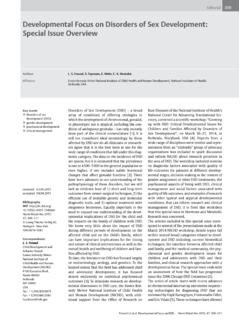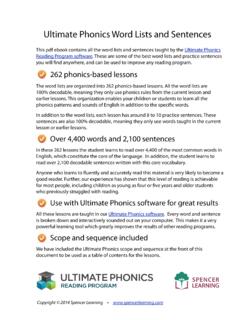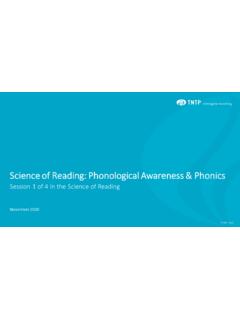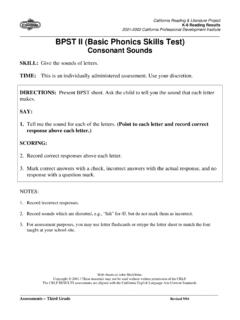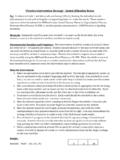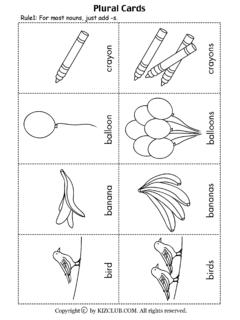Transcription of PART II: PHONICS INSTRUCTION
1 Report part II: PHONICS INSTRUCTION . Executive Summary Introduction not absolute, however, and some PHONICS programs combine two or more of these types of INSTRUCTION . In Learning to read is a complex task for beginners. They addition, these approaches differ with respect to the must coordinate many cognitive processes to read extent that controlled vocabulary (decodable text) is accurately and fluently, including recognizing words, used for practicing reading connected text. Although constructing the meanings of sentences and text, and differences exist, the hallmark of systematic PHONICS retaining the information read in memory. An essential programs is that they delineate a planned, sequential set part of the process for beginners involves learning the of phonic elements and they teach these elements alphabetic system, that is, letter-sound correspondences explicitly and systematically.
2 The goal in all PHONICS and spelling patterns, and learning how to apply this programs is to enable learners to acquire sufficient knowledge in their reading. Systematic PHONICS knowledge and use of the alphabetic code so that they INSTRUCTION is a way of teaching reading that stresses the can make normal progress in learning to read and acquisition of letter-sound correspondences and their comprehend written language. use to read and spell words (Harris & Hodges, 1995). PHONICS INSTRUCTION is designed for beginners in the The purpose of this report is to examine the research primary grades and for children having difficulty evidence concerning systematic PHONICS INSTRUCTION . learning to read. The research literature was searched to identify experiments that compared the reading performance of In teaching PHONICS explicitly and systematically, several children who had received systematic PHONICS different instructional approaches have been used.
3 INSTRUCTION to the performance of children given These include synthetic PHONICS , analytic PHONICS , nonsystematic PHONICS or no PHONICS INSTRUCTION . The embedded PHONICS , analogy PHONICS , onset-rime PHONICS , National Reading Panel (NRP) sought answers to the and PHONICS through spelling. Although all explicit, following questions: systematic PHONICS approaches use a planned, sequential introduction of a set of phonic elements along Does systematic PHONICS INSTRUCTION help children with teaching and practice of those elements, they learn to read more effectively than nonsystematic differ across a number of other features. For example, PHONICS INSTRUCTION or INSTRUCTION teaching no the content covered ranges from a limited to an PHONICS ? elaborate set of letter-sound correspondences and Are some types of PHONICS INSTRUCTION more PHONICS generalizations.
4 In addition, the application effective than others? Are some specific PHONICS procedures taught to children vary. Synthetic PHONICS programs more effective than others? programs teach children to convert letters into sounds Is PHONICS INSTRUCTION more effective when students or phonemes and then blend the sounds to form are taught individually, in small groups, or as whole recognizable words. Analytic PHONICS avoids having classes? children pronounce sounds in isolation to figure out words. Rather children are taught to analyze letter- Is PHONICS INSTRUCTION more effective when it is sound relations once the word is identified. PHONICS introduced in kindergarten or 1st grade to students through-spelling programs teach children to transform not yet reading or in later grades after students sounds into letters to write words.
5 PHONICS in context have begun to read? approaches teach children to use sound-letter Is PHONICS INSTRUCTION beneficial for children who correspondences along with context cues to identify are having difficulty learning to read? Is it effective unfamiliar words they encounter in text. Analogy in preventing reading failure among children who PHONICS programs teach children to use parts of written are at risk for developing reading problems in the words they already know to identify new words. The future? Is it effective in remediating reading distinctions between systematic PHONICS approaches are 2-89 National Reading Panel Chapter 2, part II: PHONICS INSTRUCTION difficulties among children who have not made disabled readers; older children who were progressing normal progress in learning to read?
6 Poorly in reading and who varied in intelligence with at Does PHONICS INSTRUCTION improve children's ability least some of them achieving poorly in other academic to read and comprehend text as well as their areas, referred to as low-achieving readers. decoding and word-reading skills? For children to learn to read, several capabilities must Does PHONICS INSTRUCTION have an impact on be developed. The focus of systematic PHONICS children's growth in spelling? INSTRUCTION is on helping children acquire knowledge of the alphabetic system and its use to decode new words, Is PHONICS INSTRUCTION effective with children at and to recognize familiar words accurately and different socioeconomic (SES) levels? automatically. Knowing how letters correspond to Does the type of INSTRUCTION given to control groups phonemes and larger subunits of words is essential for as part of a study to evaluate PHONICS make a enabling beginning readers to sound out word segments difference?
7 And blend these parts to form recognizable words. If PHONICS INSTRUCTION is found to be more effective Alphabetic knowledge is needed to figure out new than less- PHONICS or no- PHONICS INSTRUCTION , were words by analogy and to help beginners remember the experiments that showed these effects well words they have read before. Knowing letter-sound designed or poorly designed? relations also helps children to be more accurate in predicting words from context. In short, knowledge of Beginning reading programs that do not teach PHONICS the alphabetic system contributes greatly to children's explicitly and systematically may be of several types. In ability to read words in isolation or connected text. whole-language programs, the emphasis is upon meaning-based reading and writing activities.
8 PHONICS To study whether systematic PHONICS INSTRUCTION INSTRUCTION is integrated into these activities but taught improves children's ability to read words in various incidentally as teachers decide it is needed. Basal ways, different measures have been used. Decoding programs consist of a teacher's manual and a complete was tested by having children read regularly spelled set of books and materials that guide the teaching of words. To test whether children could read novel beginning reading. Some basal programs focus on words, pseudowords ( , gan, bloff, trusk) were used. whole-word or meaning-based activities with limited Sight vocabulary was examined through sets of leveled, attention to letter-sound constituents of words and little miscellaneous words, not all of which were spelled or no INSTRUCTION in how to blend letters to pronounce regularly.
9 In addition to word-reading, children's words. In sight word programs, children begin by performance on measures of oral reading, text building a reading vocabulary of 50 to 100 words, and comprehension, and spelling was measured. then later they learn about the alphabetic system. These To provide solid evidence, experiments to test the types of non- PHONICS programs were among those contribution of systematic PHONICS INSTRUCTION to reading taught to children in the control groups of experiments acquisition must be well designed. Random assignment examined by the NRP. Distinctions among the various of students to treatment and control groups is a types of non- PHONICS programs are not absolute. procedure that controls for other factors and allows However, their defining characteristic is that they do not researchers to conclude that the treatment itself was provide explicit, systematic PHONICS INSTRUCTION .
10 The cause of any growth in reading. However, PHONICS programs have been used to teach young sometimes the realities of schools and teachers make it children to read as they progress through the primary impossible to randomly assign students, so researchers grades and to remediate the reading difficulties of poor have to use quasi-experimental designs, assigning readers. The Panel analyzed studies that examined the treatment and control conditions to already existing effectiveness of PHONICS programs with three types of groups. Although researchers should administer pretests problem readers: children in kindergarten or 1st grade to determine whether the treatment and control groups who were at risk for developing reading problems; older differed prior to treatment and then remove any children of average or better intelligence who were not differences statistically when outcomes are analyzed, making normal progress in reading, referred to as this is not always done.




